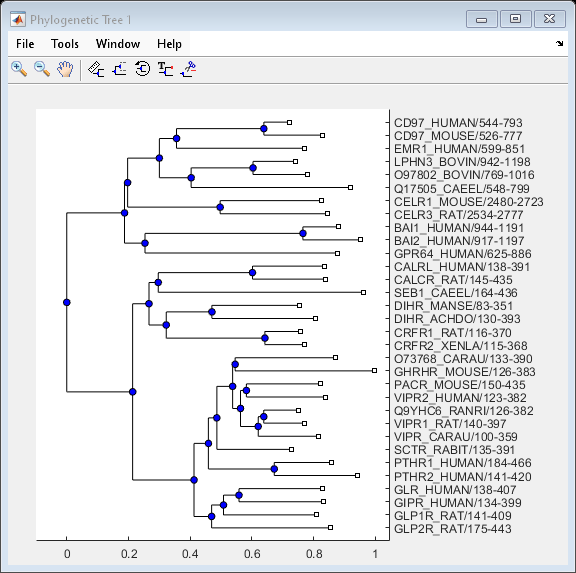seqneighjoin
Construct phylogenetic tree using neighbor-joining method
Syntax
PhyloTree = seqneighjoin(Distances)
PhyloTree = seqneighjoin(Distances, Method)
PhyloTree = seqneighjoin(Distances, Method, Names)
PhyloTree = seqneighjoin(...,
'Reroot', RerootValue)
Input Arguments
Distances | Matrix or vector containing biological distances between pairs
of sequences, such as returned by the seqpdist function. |
Method | Character vector or string specifying a method to compute the distances between nodes.
Choices are 'equivar' (default) or
'firstorder'. |
Names | Either of the following:
Distances. |
Description
PhyloTree = seqneighjoin(Distances)PhyloTree,
a phylogenetic tree object, from Distances,
pairwise distances between the species or products, using the neighbor-joining
method.
PhyloTree = seqneighjoin(Distances, Method)Method,
a method to compute the distances of the new nodes to all other nodes
at every iteration. The general expression to calculate the distances
between the new node, n, after joining i and j and
all other nodes (k), is given by
D(n,k) = a*D(i,k) + (1-a)*D(j,k) - a*D(n,i) - (1-a)*D(n,j)
This expression is guaranteed to find the correct tree with additive data (minimum variance reduction).
Choices for Method are:
| Method | Description |
|---|---|
equivar (default) | Assumes equal variance and independence of evolutionary distance estimates (a = 1/2), such as in the original neighbor-joining algorithm by Saitou and Nei, JMBE (1987) or as in Studier and Keppler, JMBE (1988). |
firstorder | Assumes a first-order model of the variances and covariances
of evolutionary distance estimates, with 'a' being
adjusted at every iteration to a value between 0 and 1,
such as in Gascuel, JMBE (1997). |
PhyloTree = seqneighjoin(Distances, Method, Names)Names,
a list of names (such as species or products), to label the leaf nodes
in the phylogenetic tree object.
specifies
whether to reroot PhyloTree = seqneighjoin(...,
'Reroot', RerootValue)PhyloTree. Choices are true (default)
or false. When RerootValue is false, seqneighjoin excludes
rerooting the resulting tree, which is useful for observing the original
linkage order followed by the algorithm. By default seqneighjoin reroots
the resulting tree using the midpoint method.
Examples
References
[1] Saitou, N., and Nei, M. (1987). The neighbor-joining method: A new method for reconstructing phylogenetic trees. Molecular Biology and Evolution 4(4), 406–425.
[2] Gascuel, O. (1997). BIONJ: An improved version of the NJ algorithm based on a simple model of sequence data. Molecular Biology and Evolution 14 685–695.
[3] Studier, J.A., Keppler, K.J. (1988). A note on the neighbor-joining algorithm of Saitou and Nei. Molecular Biology and Evolution 5(6) 729–731.
Version History
Introduced before R2006a
See Also
multialign | phytree | seqlinkage | seqpdist | cluster | plot | reroot | view
